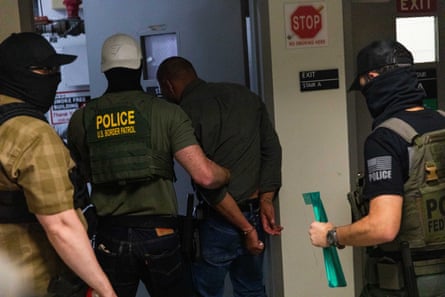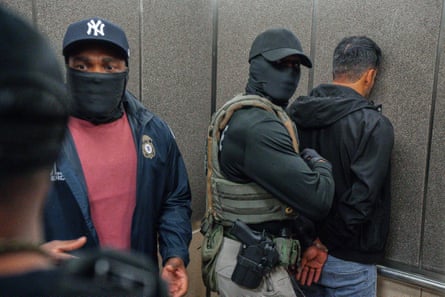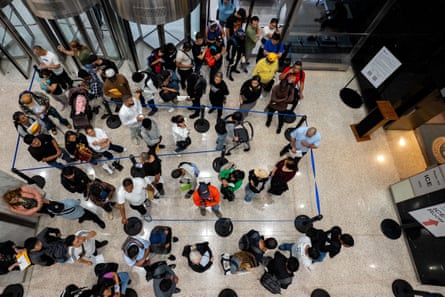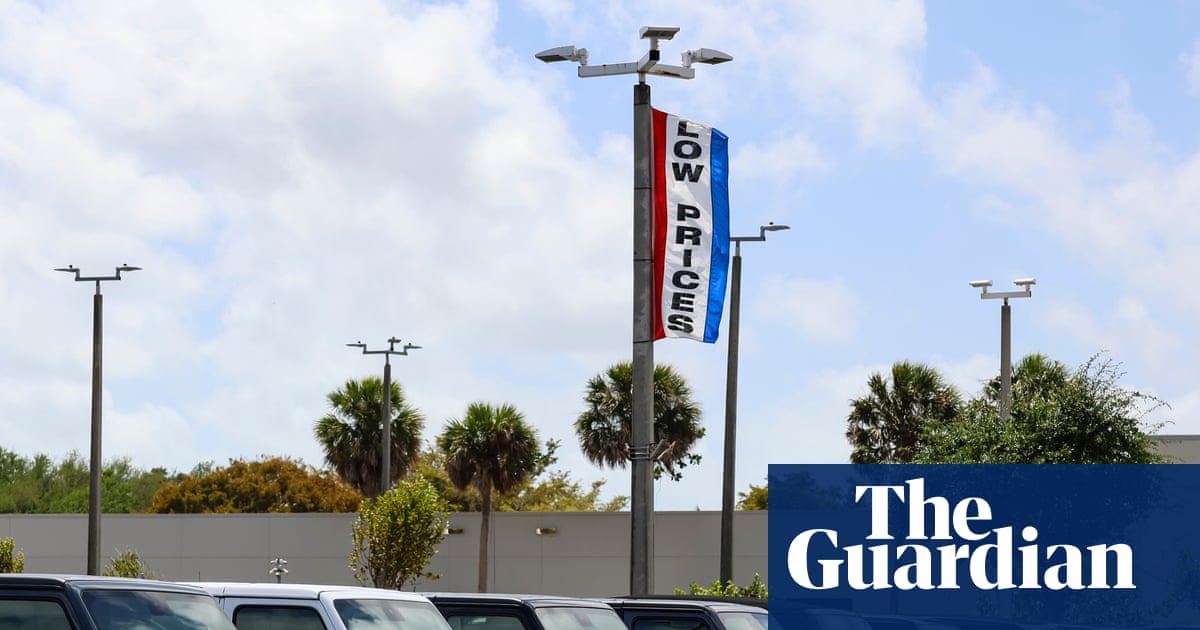The Cuban asylum seeker referred to in court papers as EC could not believe his luck, and neither could his lawyers.
They had come to immigration court in Miami in late spring expecting only incremental progress in a case that had been grinding away for more than three years. Yet here was the Department of Homeland Security (DHS) lawyer telling the judge the government was dropping its deportation demands. It seemed EC had won, eligible at last for a green card and permanent residency in the United States.
“I was a little taken aback that they were essentially conceding the point,” his lawyer, Javier Taveras, said. “But it was very welcome news.”
The judge granted the dismissal and instructed EC, whom the Guardian is not identifying in line with his lawyers’ desire to protect his identity, to wait in the next room while court staff drew up a written order.
EC’s team did not know, though, that just the day before, the DHS had issued guidance to its attorneys to look for cases that could be dismissed – not because the government intended to relax its hardline stance on deportations but rather the opposite. The Trump administration was looking to short-circuit the normal judicial procedure and make it easier to arrest, detain and deport migrants by taking them out of the jurisdiction of the court system and reclassifying them as emergency cases requiring immediate enforcement action.
In other words, down was suddenly up, and what a day earlier would have been an unequivocal victory for EC was now very bad news indeed. Agents with US Customs and Immigration Enforcement (Ice) slapped him in handcuffs directly outside the courtroom. Taveras’s team raced back to the judge to demand that the case be reopened on the grounds that their client had been deliberately misled, still hoping that the judge might feel similarly himself.
“As an officer of the court, the government lawyer can’t argue one thing knowing that what is intended is another,” Taveras charged. “They basically lied to the court.”
The judge, though, refused to revisit the decision. Days later, EC’s lawyers and his American wife learned he was in detention at the opposite end of the country, in Tacoma, Washington, under threat of “expedited removal” – a category that, before Trump, was largely reserved for new arrivals, most of them apprehended at or near the border, not people like EC who have been in the country for years and have given the authorities no cause for concern.
Chaos in immigration courts
It wasn’t just EC and his lawyers who were blindsided. In case after case, starting in late May, immigration lawyers around the US have been stunned to see cases they have worked on for years disappear into a black hole and their clients subjected to perils they never imagined. Lawyers from four different states and multiple jurisdictions described how the world they knew – of fixed rules and procedures even in a messy, heavily backlogged system – had in effect vanished overnight, leaving hundreds of thousands of migrants, many of whom have spent years working their way through the courts, at risk of an abrupt reversal in their fortunes.
“I was shocked,” Taveras said. “If they can change the rules and move the goalposts mid-game, what are we even doing here?”
Dismissing cases in this way may just be the beginning. According to a broad cross-section of immigration professionals, including lawyers, former judges and former federal officials, the administration’s full ambition is not just to bend the rules to fulfill deportation quotas, but to dismantle the immigration court system as it has been configured for the past 40 years – and with it an important plank of the justice system as a whole.
“This is about making the executive branch the dictator,” said Ashley Tabaddor, a former president of the National Association of Immigration Judges who served as a senior DHS lawyer under the Biden administration.

The attack, Tabaddor and others say, is being mounted on multiple fronts: eliminating courthouses as safe spaces where immigrants can appear in good faith without fear of arrest; eliminating the possibility of bail for immigrants ordered into detention; gutting the infrastructure of help desks and orientation programs designed to help immigrants who cannot afford a lawyer and cutting funds that provide legal representation to unaccompanied children; limiting the independence of immigration judges and firing those who do not appear to be in line with the administration’s desire to hasten deportations; and eroding if not eliminating a carefully erected firewall between the DHS, which is in charge of immigration enforcement, and the justice department, which administers the immigration courts.
“All of this shows a callousness and complete disregard for people’s humanity,” Tabaddor added. “They want to be able to deport people like they are shooting fish in a barrel.”
In response, the justice department office responsible for the immigration courts confirmed it had rescinded more than 20 policies, which it argued were “unfounded in law or discouraged the timely completion of cases” and added: “Reducing the immigration court backlog is one of the highest priorities for the agency.”
The DHS, for its part, defended the arrest of immigrants at courthouses, calling the policy “common sense” since Ice could be sure of finding its targets there and could be sure, too, that they were unarmed since they had passed through courthouse metal detectors.
“We aren’t some medieval kingdom,” the DHS assistant secretary Tricia McLaughlin said. “There are no legal sanctuaries where you can hide and avoid the consequences for breaking the law. Nothing in the constitution prohibits arresting a lawbreaker where you find them.”
The second Trump administration began making some of these moves out of the gate, but the big shift, immigration professionals say, came in May, when Stephen Miller, the White House deputy chief of staff in charge of immigration policy, demanded a dramatic increase in deportations from a few hundred to 3,000 a day.
While Ice began aggressive new sweeps of immigrant workers, starting in Los Angeles, administration officials issued policy guidelines greatly diminishing the leeway many of those immigrants had to be able to stay in the country.
Days after the DHS told its lawyers to press for dismissals of slow-moving asylum cases so they could be reassigned as emergency deportations, two senior immigration court administrators, one in Los Angeles and another in Florida, issued instructions on behalf of the justice department’s executive office of immigration review (EOIR) essentially ordering judges not to stand in the DHS’s way.
EC’s family told him about the transfer to Washington state three days later. The government, he said, did not update him.
Taveras and his team also made every effort to be with EC when he was summoned for a “risk interview” to assess the dangers he might face back in Cuba. But they were given no notice, and their client was told he would have to face the interview alone if he didn’t want to wait several more weeks in detention for a new date.

EC is one of tens of thousands of immigrants that the Trump administration has moved long distances around the country, a Guardian investigation has found, a practice at odds with past Ice protocols that immigration advocates say seems designed to limit detainees’ access to their constitutional rights.
Another bewildering change that Hayden Rodarte, an immigration specialist with the Lawyers’ Committee for Civil Rights in San Francisco, and other immigration lawyers say they have seen involves the government’s handling of residency permits for family members once an immigrant has been granted asylum. By law, spouses and minor children have the same right to stay in the US, but increasingly they are subject to close scrutiny and multiple in-person interview appointments, any one of which can lead to arrest and expedited deportation proceedings for reasons that can be hard to anticipate.
Rodarte said he now advises close family members they might be better off remaining undocumented, because the risk of claiming their legal due has become “huge”.
“What looks at first like a blessing turns into safety planning,” he said. “The administration is using systems that are supposed to protect people as traps and is weaponizing as many pieces of the immigration system as possible to put people on Ice’s radar for the sheer purpose of removing them.”
Rodarte likened these tactics to the family separation policy that the first Trump administration pursued in 2017-18, the difference this time being that the separation is not occurring at the border but in homes, workplaces, schools and courthouses. “The upshot is the same,” he added. “This is about cornering humans and making them suffer as much as possible.”
Administration critics say it is also making a mockery of the very concept of immigration law. “Defending people against removal proceedings is the heart of what we practice,” said Lisa Anderson, a lawyer in Los Angeles. “If you change that, people are no longer being afforded due process.”
A similar argument is at the heart of a federal lawsuit, filed in July, which calls the new courthouse guidelines “arbitrary and capricious” and accuses the Trump administration of breaking multiple federal laws as well as violating the constitution’s due process clause. (The government is yet to respond.)
EC is one of eight lead plaintiffs named in the suit, which the Chicago-based National Immigrant Justice Center is spearheading on behalf of two other immigrant rights organizations. It estimates that “hundreds and possibly thousands” of immigrants had their cases dismissed in immigration court and were reassigned for emergency deportation between late May and mid-July. The total number at risk is likely to be much higher – as high as 300,000, according to Tabaddor, based on the number of people working their way through the system.
“It’s the first time we’ve seen anything like this at this magnitude,” she said.
It was also the first time, she said, that an administration had taken aim at immigration judges. In memo after memo from the justice department’s EOIR, judges have been told that if they do not stick to guidelines of what Trump’s justice department regards as impartial decision-making and “fidelity to the law” they risk losing their jobs – and many of them have.
Out of about 750 immigration judges who were serving in January, more than a hundred have been fired, according to court dockets and data collected by a professional union. To address what was already a chronic backlog of cases, the administration has proposed sending in hundreds of military lawyers to serve in their place, offering just two weeks’ training to familiarize them with the relevant areas of the law.

Many of the veteran judges who have been dismissed granted asylum in a high percentage of cases – sometimes 90% or higher, according to a Syracuse University website that tracks the data. Immigration experts say those rates can depend on jurisdiction as much as personal temperament, but the justice department has decried them as “statistically improbable outcome metrics” for which the judges involved merit professional discipline.
The judges themselves were given no reason for being fired, according to at least half a dozen who have shared the short email they received, other than article II of the constitution, which details the president’s executive powers. Some have spoken out to denounce their treatment as arbitrary, unfair and an attack on the rule of law.
It’s a sentiment that Tabaddor echoed based on her own 15-plus years on the immigration court and, before that, as a lawyer representing the federal government. “My entire life has been dedicated to the principles of justice and integrity … and humanity, and it feels like I just watched my child being murdered,” Tabaddor said. “Everything has been turned on its head. What’s happening in immigration court is just another symptom of a full-frontal assault and takeover of the Department of Justice. This is not normal. This is not defensible.”
The justice department declined to respond.
Targeting the judges themselves
The immigration courts as they are known today were created in 1983 to separate out the functions of immigration enforcement, then still housed within the justice department, and the adjudication of cases. In other words, judicial independence and the constitutional right to due process were the core reason for the courts to exist at all. “They did a study and concluded it doesn’t pass the laugh test to have the same people wearing the enforcement hats and making the final decisions about people’s future,” Tabaddor recounted.
The system was far from perfect, and immigration judges enjoyed only what the EOIR described as “quasi-judicial functions”, meaning they were regarded as legal administrators more than full justices. Still, they enjoyed significant job protections and could only be removed for cause.
That began to change during the first Trump administration, which pushed to decertify the National Association of Immigration Judges, essentially the judges’ union, that had acted as a guarantor of the judges’ job security and with it their independence. The lone Democrat on a key federal review body denounced the decertification as an exercise in “legal gymnastics”, but it went through at the tail-end of Trump’s first term on a party-line vote.

The second Trump administration came in with guns blazing, immediately firing the top leadership of EOIR. It also went after immigration judges themselves, as it did against large swaths of federal workers, designating them “inferior officers” – meaning they needed to defer to more senior political appointees confirmed by the Senate – and firing large numbers of them at will.
It wasn’t just senior judges with high asylum approval rates that came under the axe. Senate Democrats noticed the administration was failing to convert roughly half of the newest judicial appointees at the end of their probationary period – in almost all cases ditching the ones who had previously worked as lawyers representing immigrants and keeping the ones who had worked in immigration enforcement.
Then, starting in May, came a series of unprecedented rulings and memos from the EOIR. One stripped judges’ ability to grant bail in detention cases. Another set a dauntingly high standard for determining whether Salvadorian nationals faced a legitimate fear of imprisonment and torture if returned home – despite that country’s well-documented history of human rights abuses.
The upshot was, once again, to constrain rank-and-file immigration judges’ room for maneuver. An 22 August memo from EOIR’s acting director, Sirce Owen, warned that judicial independence “is not a license to ignore a clear directive from a proper appellate authority … [Immigration judges] do not possess intrinsic, free-floating equitable authority”.
The instruction to allow the government to reassign asylum and other ordinary immigration cases, even without cause, fits into the overall pattern of imposing limits on how judges can rule while nominally continuing to defer to their independent authority. Immigration lawyers now routinely petition judges to allow their clients to appear in court remotely so they don’t have to run a gauntlet of Ice agents at the courthouse. But judges are increasingly denying those requests.
“Some court judges seem to be in collusion with immigration officials to make these arrests,” said Priscilla Olivarez, a San Antonio-based attorney with the Immigrant Legal Resource Center. She said she routinely sees between 10 and 15 Ice officers in the hallways of one of the courthouses where she appears. “It is clear this is calculated,” she added, “to stoke fear in our communities, create misinformation, and prevent people from accessing their right to seek asylum and the different types of relief that stem from it”.
The DHS did not respond directly to the charge that it was coordinating with judges, saying only: “The average illegal alien gets far more due process than most Americans.”
Recategorizing asylum cases and expediting deportation was not unheard of before this summer, but advocates say it would happen on a case-by-case basis and usually when the contours of a case had changed in a fundamental way – for example, if evidence emerged of a past violent crime. Sometimes, incoming administrations have instructed immigration courts to prioritize certain cases in line with their policy goals – a practice known as “docket shuffling” – but never in a way that threatened the futures of hundreds of thousands of people.

“All concept of what we as attorneys do, of the rule of law, of what is ethical and what is legal – they’ve blown past all of that,” said Rodarte, the San Francisco lawyer. “They’re even blowing past court orders. They’re doing what they want and saying if you don’t like it, come at us … They’re turning a blind eye to the rules to meet their deportation goals at whatever cost.”
What the government’s own immigration lawyers make of the sweeping policy changes they are expected to carry out is not entirely clear. In appearances at two different Los Angeles-area immigration courts recently, some demonstrated a maximalist approach to arguing against asylum, pressing for deportation no matter what, while others took time to show understanding for migrants who have been in the country a long time and face challenges from the burden of paying for an immigration lawyer to caring for sick family members.
In one of the hearings, the DHS lawyer, whom the Guardian is not naming because of concerns that her job might be at risk, said the government had no issue with a Mexican couple arguing to stay in the United States because their deportation would create “exceptional and extremely unusual hardship” for their US-born disabled son.
As the hearing was winding down, Anderson, the lawyer representing the family, turned to her opposing counsel and said: “I imagine you guys are quite busy.”
The government lawyer, mindful perhaps of the announced presence of a reporter, offered a nervous giggle, but no answer.

 German (DE)
German (DE)  English (US)
English (US)  Spanish (ES)
Spanish (ES)  French (FR)
French (FR)  Hindi (IN)
Hindi (IN)  Italian (IT)
Italian (IT)  Russian (RU)
Russian (RU)  3 weeks ago
3 weeks ago
























Comments